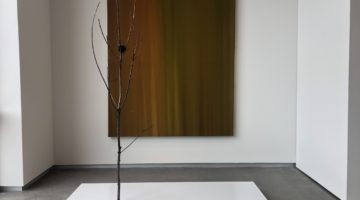
A new art exhibit has arrived at UNR’s Lilley Museum featuring work from Shane Pickett. The exhibit is called “Shane Pickett: Djinong Djina Boodja | Look at the Land I Have Travelled.”
Pickett was known for gestural abstraction and the exhibit mostly featured acrylic on linen from 2007 to 2009. He was a significant contemporary Aboriginal artist from Western Australia and his Nyoongar culture heavily influenced his art. Pickett passed away in early 2010 and the works he created in his last years are among his most engaging.
The walls of the museum order Pickett’s work chronologically from 2007 on the left wall and moves up to 2009 around the back and to the right wall. Each year feels different and while every piece is abstract to a degree, it moves further into abstractness after 2007.
Every piece was captivating in its own way and each tried to get across an idea through its colors and patterns. The first work on the left wall is “Munguroo Grounds and Songlines after the Sunset” and depicts a horizon with chalky reds, warm browns and whites.
Each brush stroke in the work, and in other pieces as well, is smooth with rough edges and a gentle flow. White dots also adorn some of his paintings and they are presented periodically following some of the directional currents of the strokes.
Pickett’s 2008 works align the back wall of the museum. These pieces are a little different and composed of the similar acrylic on linen, but some pieces were created with ink on paper.
His work with acrylic on linen was different from the work done in 2007. These 2008 pieces use more whites, blues, light browns and some yellows. This gave off a cooler presentation, but the use of white as the background color does something else as well. The strokes crash against the white background which creates a sense of harshness, but there is still the underlying flow that Pickett utilizes. “The Healing Waterhole Below Rock Wall” illustrates this all very well with between its two canvases.
Pickett was also skilled when using ink on paper. The exhibit featured some smaller pieces that each demonstrated one of the six seasons of the Nyoongar people. The spirit of each season is captured in ink and had a different look compared to any of his acrylic paintings. Each had a unique color attribute which feels elemental and carries the essence of the season.
While many of Pickett’s acrylic paintings were dreamlike with warm and cool colors, others felt more nightmarish. Two paintings featured darker, more foreboding reds and blacks, which were intimidating and unsettling. “Wanyarang Winds Calling Bunuro” uses reds in a manner that feel as if fresh blood had just been applied to the canvas. Both of these paintings were well done and evoked a reaction, but were surprising considering the other paintings up to that point.
Finally, four works from 2009 hang on the walls of the museum. Each of these felt distinct from what had come before. They were still painted using acrylic and linen, and all still use abstraction to convey ideas.
Despite their similarities, these four were almost monochromatic using white and black with some grays as well, and they were much smaller than the other acrylic paintings. They were cloudy, rough, personal, and while the names of each described smoke and other ideas, each one had a human touch as if they were depicting faces beneath the canvas.
The exhibit will be located in The Lilley Museum until Feb. 4 and is free of charge.
Jayden Perez can be reached at ryleejackson@sagebrush.unr.edu, or on Twitter @Jayden_Perez13.










